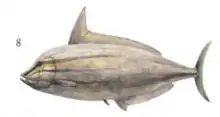Paranogmius
Paranogmius is an extinct genus of prehistoric bony fish that lived during the Cenomanian.[1] It is known from a single vertebra discovered in the Bahariya Formation. The bone was destroyed during World War II and since then, no more fossils have been discovered. It may have been up to 4 metres (13 ft) long when fully grown, although this is just a very rough estimate.
| Paranogmius | |
|---|---|
 | |
| Restoration of Paranogmius | |
| Scientific classification | |
| Kingdom: | |
| Phylum: | |
| Class: | |
| Order: | |
| Subfamily: | |
| Genus: | †Paranogmius |
| Binomial name | |
| †Paranogmius doederleini Stromer, 1915 | |
Paranogmius doederleini may have been the same animal as Concavotectum moroccensis.[3][4]
References
- Sepkoski, Jack (2002). "A compendium of fossil marine animal genera". Bulletins of American Paleontology. 364: 560. Retrieved 2009-02-27.
- "Crossognathiformes". Paleobiology Database. Retrieved July 11, 2013.
- Cavin L, Tong H, Boudad L, Meister C, Piuz A, Tabouelle J, et al. (2010) Vertebrate assemblages from the early Late Cretaceous of southeastern Morocco: An overview. Journal of African Earth Sciences Geological Society of Africa Presidential Review No 16 57: 391–412.
- Mesozoic Fishes 4 - Homology and Phylogeny, Chapter: A new tselfatiiform teleost from the Upper Cretaceous (Cenomanian) of the Kem Kem beds, Southern Morocco, Publisher: Verlag Dr. F. Pfeil, Editors: Gloria Arratia, Hasn-Peter Schiultze, Mark V. H. Wilson, pp.199-216
This article is issued from Wikipedia. The text is licensed under Creative Commons - Attribution - Sharealike. Additional terms may apply for the media files.